Friction Materials Market Size
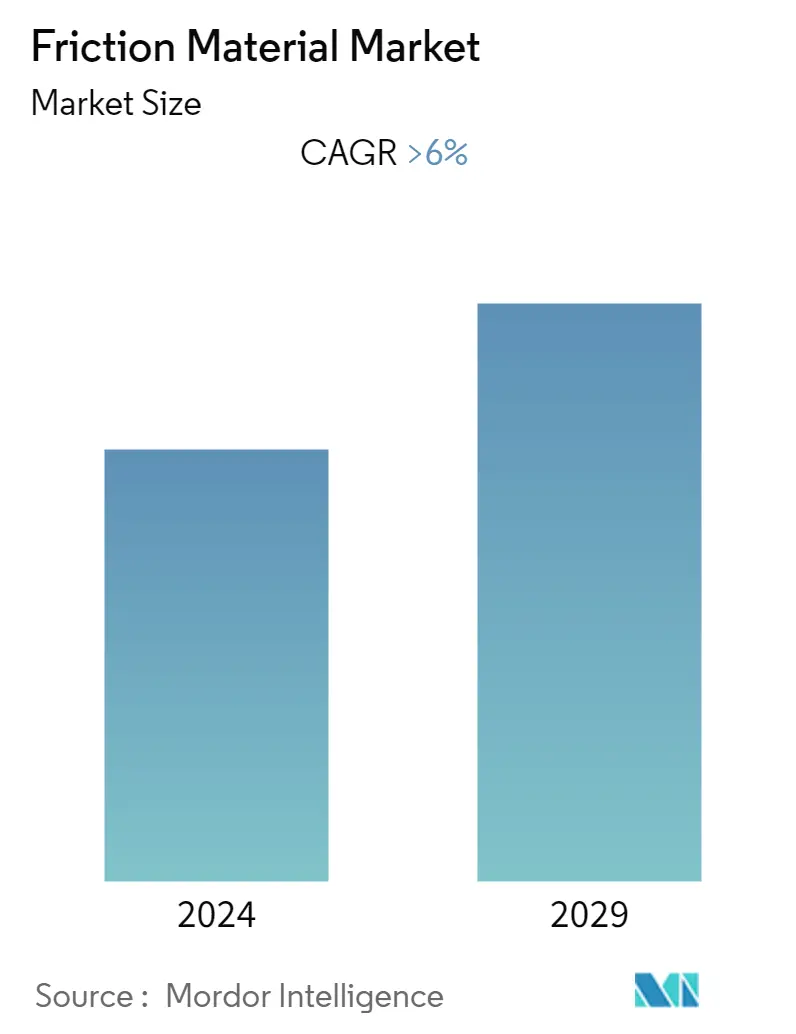
| Study Period | 2019 - 2029 |
| Base Year For Estimation | 2023 |
| CAGR | 6.00 % |
| Fastest Growing Market | Asia Pacific |
| Largest Market | Asia Pacific |
| Market Concentration | High |
Major Players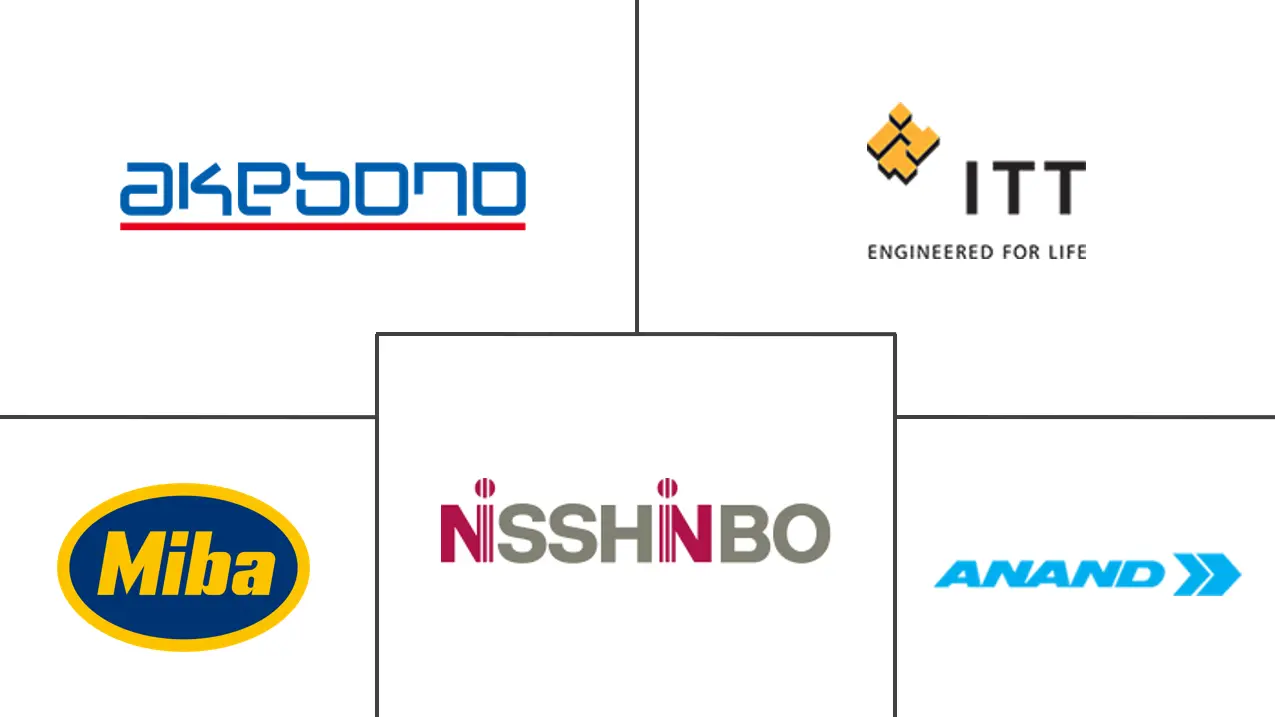
*Disclaimer: Major Players sorted in no particular order |
Friction Materials Market Analysis
The friction material market is projected to register a CAGR of over 6% during the forecast period (2021-2026).
The market was negatively impacted by COVID-19 in 2020. During the pandemic scenario, automotive manufacturing activities were stopped temporarily during the lockdown, thereby decreasing the consumption of friction materials used in vehicles' clutches, gears, braking systems, and others. Furthermore, the passenger train and air transport facilities were halted during the pandemic for a long duration of time, which decreased the consumption of friction materials used in the braking systems of trains and clutches, brakes, and gears of aircraft. However, freight trains were running at full pace. For instance, the total freight loading through Indian railways amounted to about 57.47 million ton till August 19, 2020, with a growth rate of 6.6% compared to the same period of 2019, which has enhanced the demand for friction materials used in the braking systems of freight trains.
Over the short term, the growing need for friction material products for various industrial machinery is expected to drive the market's growth.
On the flip side, the high cost and maintenance of friction materials are expected to hinder the market growth.
The Asia-Pacific region is expected to dominate the market during the forecast period due to the huge consumption from countries such as China, India, and Japan.
Friction Materials Market Trends
This section covers the major market trends shaping the Friction Material Market according to our research experts:
The Automotive Industry Dominates the Market
Friction materials have been increasingly used in both light- and heavy-duty vehicles. In vehicles, friction materials find their applications in clutches, brakes, and gears, among others.
Friction brakes are used to decelerate a vehicle by transforming the kinetic energy of the vehicle to heat via friction and dissipating that heat to the surroundings.
Among all the materials used, sintered metal materials are well-suited for heavy-duty applications, such as mining vehicle transporters.
Ceramic material clutches can withstand considerable heat, and they can operate without fading at temperatures up to 550°C due to repeated engagement and disengagement of the clutch. This heat resistance property makes them ideal for racing applications and for use in brake technology in various high-end automobiles.
The automotive industry has seen a slowdown in the past three years. According to the International Organization of Motor Vehicle Manufacturers (OICA), automotive production witnessed a 15.8% decline from 92,175,805 units in 2019 to 77,621,582 units in 2020. Also, the sales of automobiles declined from 90.42 million units in 2019 to 77.97 million units in 2020.
The decline is majorly attributed to the reduced production in the major automotive hubs such as the United States, China, Japan, and Germany. In 2020, these countries witnessed a decline of 19%, 2%, 17%, and 24%, respectively, compared to 2019.
Therefore, the aforementioned factors are expected to significantly impact the market in the coming years.
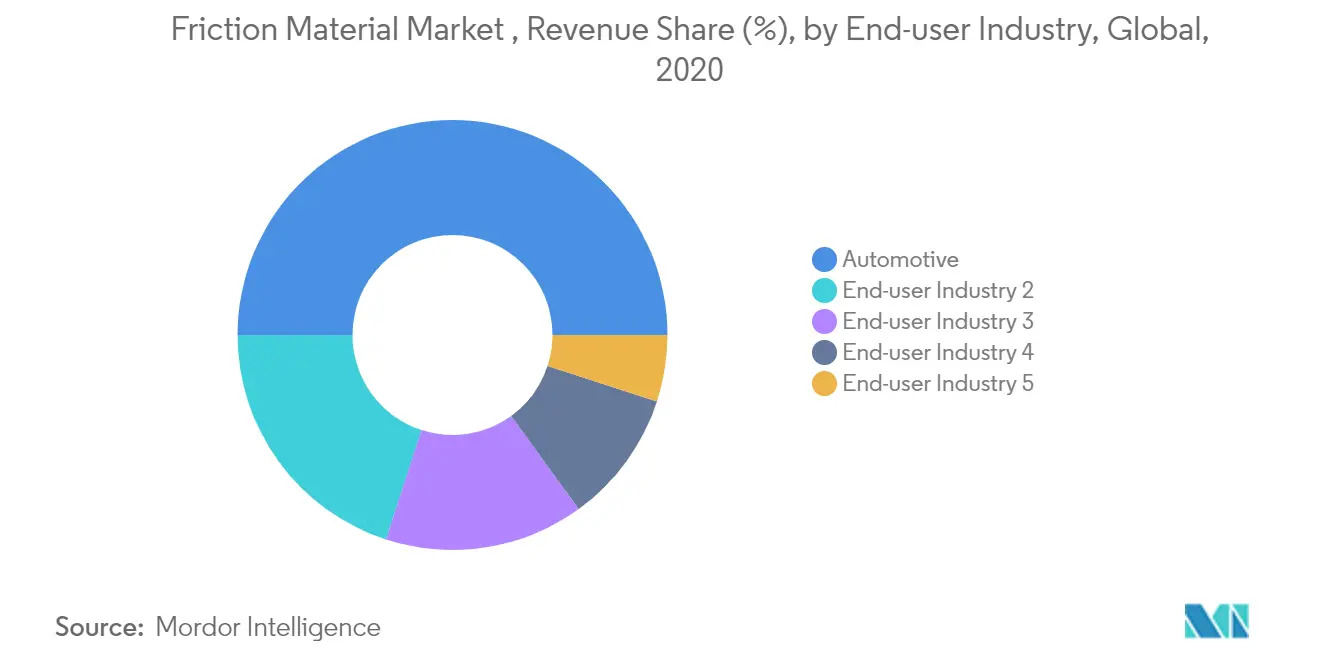
The Asia-Pacific Region is Expected to Dominate the Market
Asia-Pacific is expected to dominate the global market due to the vast industrial and automotive sectors in China and India, coupled with the continuous investments done in the region to advance the construction sector.
The growing demand for trucks, buses, trains, industrial machines, and robots in China and India drives the demand for friction materials in various applications.
The Chinese automotive manufacturing industry is the largest in the world. The industry witnessed a slowdown in 2018, wherein production and sales declined. A similar trend continued, with production witnessing a 7.5% decline in 2019. Additionally, the production volume reached 25.23 million vehicles in 2020, registering a decline rate of about 2% compared to 2019.
As the pandemic spread, many auto companies across the country shut down their manufacturing activities due to the nationwide shutdown. In addition to the auto companies based in Hubei, Tesla's new factory in Shanghai was shut down and postponed the production date of its Model 3. Moreover, Volkswagen postponed production at all of its Chinese plants that run in partnership with SAIC.
Additionally, around 3.39 million vehicles were produced in India during 2020 compared to 4.52 million vehicles produced in 2019, witnessing a decline rate of about 25%.
Friction materials also find applications in the railways. According to IBEF, the Indian Railways operates one of the world's largest rail networks, with a route length of 1,23,236 kilometers, 13,523 passenger trains and 9,146 freight trains, and transporting 23 million passengers.
The aerospace manufacturing sector is also growing rapidly in India and China, which is expected to increase the demand in the market. According to Boeing Commercial Market Outlook 2020-2039, around 17,485 new airplane deliveries will be made in the Asia-Pacific region during the period of 2020-2039. With this addition, the total airplane fleet volume in the region will reach about 18,770 units by 2039, which is expected to enhance the demand for friction materials.
Therefore, the aforementioned factors are expected to have a significant impact on the market in the coming years.
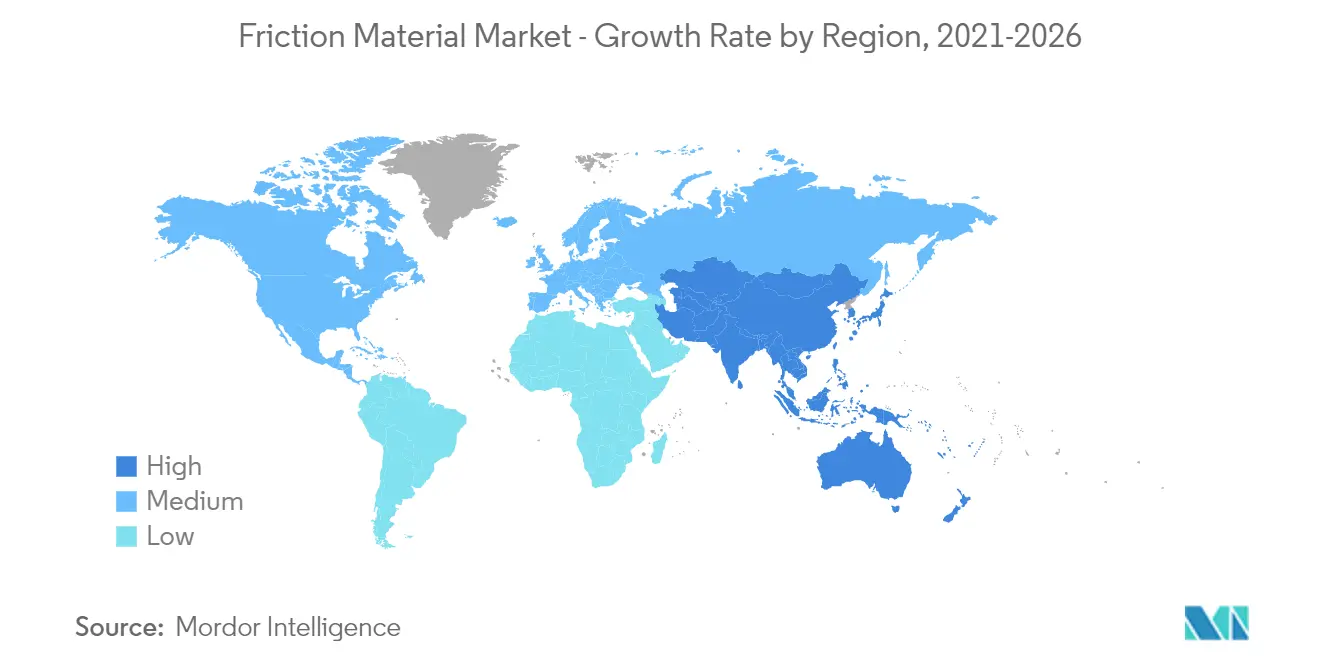
Friction Materials Industry Overview
The friction material market is partially consolidated in nature, with a few major players dominating a significant portion of the market. Some of the key players include Nisshinbo Holdings Inc., Akebono Brake Industry Co. Ltd, ITT Inc., Miba AG, and ANAND Group, among others.
Friction Materials Market Leaders
-
Nisshinbo Holdings Inc.
-
AKEBONO BRAKE INDUSTRY CO., LTD.
-
ITT INC.
-
Miba AG
-
ANAND Group
*Disclaimer: Major Players sorted in no particular order
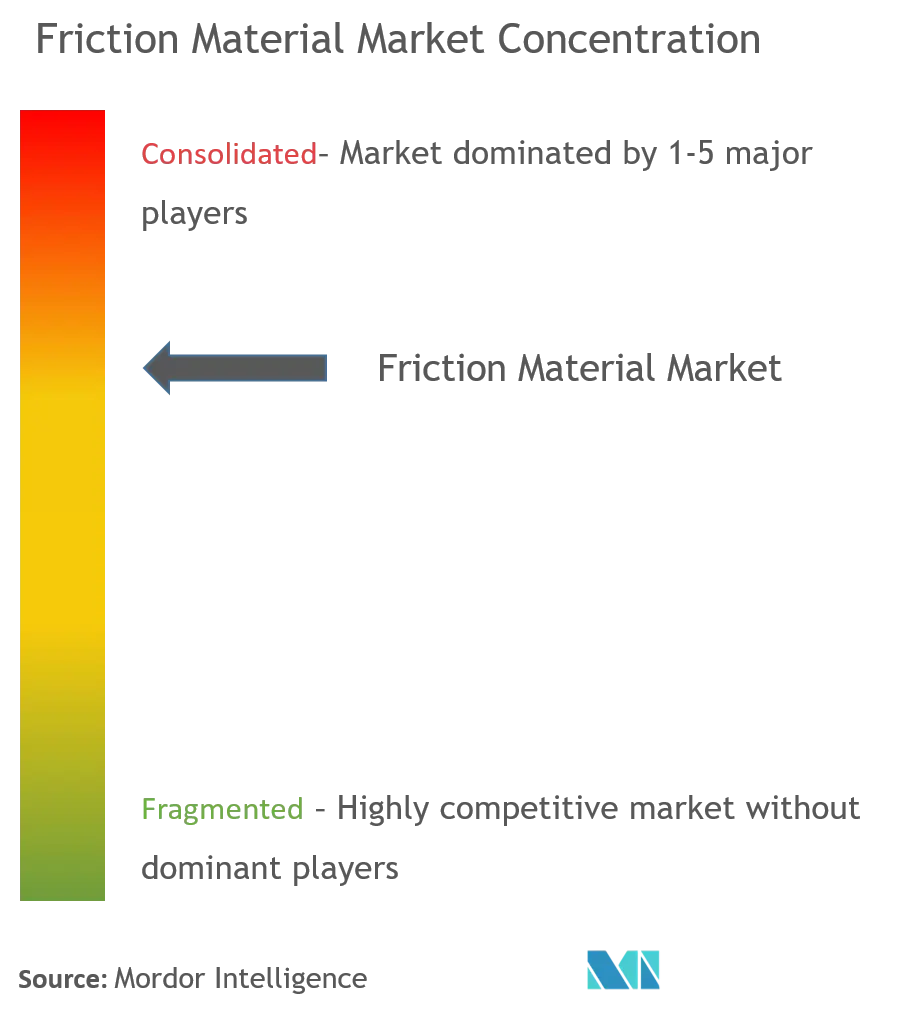
Friction Materials Market News
In November 2020, Brembo SpA signed an agreement to acquire a 100% stake in SBS Friction AS, a manufacturer of sintered and organic material brake pads for motorbikes. The agreement was expected to be completed by the first quarter of 2021, which will enhance the company's product portfolio.
In October 2018, Tenneco Inc. completed the acquisition of Federal-Mogul LLC, a manufacturer of friction material, thereby enhancing the company's product portfolio.
Friction Materials Market Report - Table of Contents
1. INTRODUCTION
- 1.1 Study Assumptions
- 1.2 Scope of the Study
2. RESEARCH METHODOLOGY
3. EXECUTIVE SUMMARY
4. MARKET DYNAMICS
-
4.1 Drivers
- 4.1.1 Growing Need for Industrial Machinery
- 4.1.2 Other Drivers
-
4.2 Restraints
- 4.2.1 High Maintenance and Cost of Friction Materials
- 4.2.2 Impact of COVID-19 Outbreak
- 4.2.3 Other Restraints
- 4.3 Industry Value Chain Analysis
-
4.4 Porter's Five Forces Analysis
- 4.4.1 Bargaining Power of Suppliers
- 4.4.2 Bargaining Power of Buyers
- 4.4.3 Threat of New Entrants
- 4.4.4 Threat of Substitute Products and Services
- 4.4.5 Degree of Competition
5. MARKET SEGMENTATION
-
5.1 Type
- 5.1.1 Discs
- 5.1.2 Pads
- 5.1.3 Blocks
- 5.1.4 Linings
- 5.1.5 Other Types
-
5.2 Material
- 5.2.1 Ceramic
- 5.2.2 Asbestos
- 5.2.3 Semi-metallic
- 5.2.4 Sintered Metals
- 5.2.5 Aramid Fibers
- 5.2.6 Other Materials
-
5.3 Application
- 5.3.1 Clutch and Brake Systems
- 5.3.2 Gear Tooth Systems
- 5.3.3 Other Applications
-
5.4 End-user Industry
- 5.4.1 Automotive
- 5.4.2 Railway
- 5.4.3 Aerospace
- 5.4.4 Mining
- 5.4.5 Other End-user Industries
-
5.5 Geography
- 5.5.1 Asia-Pacific
- 5.5.1.1 China
- 5.5.1.2 India
- 5.5.1.3 Japan
- 5.5.1.4 South Korea
- 5.5.1.5 Rest of Asia-Pacific
- 5.5.2 North America
- 5.5.2.1 United States
- 5.5.2.2 Canada
- 5.5.2.3 Mexico
- 5.5.3 Europe
- 5.5.3.1 Germany
- 5.5.3.2 United Kingdom
- 5.5.3.3 France
- 5.5.3.4 Italy
- 5.5.3.5 Rest of Europe
- 5.5.4 South America
- 5.5.4.1 Brazil
- 5.5.4.2 Argentina
- 5.5.4.3 Rest of South America
- 5.5.5 Middle-East and Africa
- 5.5.5.1 Saudi Arabia
- 5.5.5.2 South Africa
- 5.5.5.3 Rest of Middle-East and Africa
6. COMPETITIVE LANDSCAPE
- 6.1 Mergers and Acquisitions, Joint Ventures, Collaborations, and Agreements
- 6.2 Market Share Analysis**/Ranking Analysis
- 6.3 Strategies Adopted by Leading Players
-
6.4 Company Profiles
- 6.4.1 ABS Friction
- 6.4.2 ANAND Group
- 6.4.3 Akebono Brake Industry Co. Ltd
- 6.4.4 Brembo SpA
- 6.4.5 ITT Inc.
- 6.4.6 Japan Brake Industrial Co. Ltd
- 6.4.7 Miba AG
- 6.4.8 Nisshinbo Holdings Inc.
- 6.4.9 Tenneco Inc.
- 6.4.10 Yantai Haina Brake Technology Co. Ltd
- *List Not Exhaustive
7. MARKET OPPORTUNITIES AND FUTURE TRENDS
- 7.1 Growing Demand for High Thermal-resistant Friction Materials
- 7.2 Other Opportunities
Friction Materials Industry Segmentation
Friction materials are used to provide or enhance friction to decelerate or stop the system. Friction materials majorly find applications in braking systems, where they are used in brake pads and brake linings. The friction material market is segmented by type, material, application, end-user industry, and geography. By type, the market is segmented into discs, pads, blocks, linings, and other types. By material, the market is segmented into ceramic, asbestos, semi-metallic, sintered metals, aramid fibers, and other materials. By application, the market is segmented into clutch and brake systems, gear tooth systems, and other applications. By end-user industry, the market is segmented into automotive, railway, aerospace, mining, and other end-user industries. The report also covers the market sizes and forecasts for the friction material market in 15 countries across the major regions. For each segment, the market sizing and forecasts have been done on the basis of revenue (USD million).
| Type | Discs | |
| Pads | ||
| Blocks | ||
| Linings | ||
| Other Types | ||
| Material | Ceramic | |
| Asbestos | ||
| Semi-metallic | ||
| Sintered Metals | ||
| Aramid Fibers | ||
| Other Materials | ||
| Application | Clutch and Brake Systems | |
| Gear Tooth Systems | ||
| Other Applications | ||
| End-user Industry | Automotive | |
| Railway | ||
| Aerospace | ||
| Mining | ||
| Other End-user Industries | ||
| Geography | Asia-Pacific | China |
| India | ||
| Japan | ||
| South Korea | ||
| Rest of Asia-Pacific | ||
| Geography | North America | United States |
| Canada | ||
| Mexico | ||
| Geography | Europe | Germany |
| United Kingdom | ||
| France | ||
| Italy | ||
| Rest of Europe | ||
| Geography | South America | Brazil |
| Argentina | ||
| Rest of South America | ||
| Geography | Middle-East and Africa | Saudi Arabia |
| South Africa | ||
| Rest of Middle-East and Africa |
Friction Materials Market Research FAQs
What is the current Friction Material Market size?
The Friction Material Market is projected to register a CAGR of greater than 6% during the forecast period (2024-2029)
Who are the key players in Friction Material Market?
Nisshinbo Holdings Inc. , AKEBONO BRAKE INDUSTRY CO., LTD., ITT INC., Miba AG and ANAND Group are the major companies operating in the Friction Material Market.
Which is the fastest growing region in Friction Material Market?
Asia Pacific is estimated to grow at the highest CAGR over the forecast period (2024-2029).
Which region has the biggest share in Friction Material Market?
In 2024, the Asia Pacific accounts for the largest market share in Friction Material Market.
What years does this Friction Material Market cover?
The report covers the Friction Material Market historical market size for years: 2019, 2020, 2021, 2022 and 2023. The report also forecasts the Friction Material Market size for years: 2024, 2025, 2026, 2027, 2028 and 2029.
Friction Materials Industry Report
Statistics for the 2024 Friction Materials market share, size and revenue growth rate, created by Mordor Intelligence™ Industry Reports. Friction Materials analysis includes a market forecast outlook 2029 and historical overview. Get a sample of this industry analysis as a free report PDF download.



